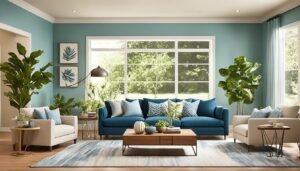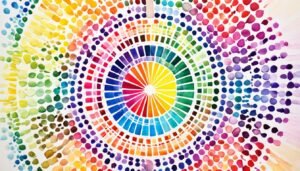
Guess what? An astonishing 88% of interior designers say their success comes from using seven key principles. These principles, like balance, harmony, and contrast, help create beautiful and functional spaces. With them, designers build rooms that look and feel just right.
Knowing these principles is key for improving your home’s look. Learn about balance, rhythm, and proportion to make any space better. Whether it’s a big project or small change, using these principles can make a big difference.
Key Takeaways
- The seven key principles of interior design are balance, harmony, rhythm, proportion and scale, emphasis, contrast, and details.
- Balance in interior design can be achieved through symmetrical, asymmetrical, or radial arrangements.
- Unity and harmony are essential for creating a cohesive, visually appealing space.
- Rhythm can be incorporated through repetitive design elements like patterns and textures.
- Proportion and scale are crucial for ensuring objects and furnishings fit harmoniously within a room.
Balance: The Art of Visual Equilibrium
Balance is key in interior design. It’s about creating visual balance in a room. This means carefully placing furniture and decorations. It aims to make the space look harmonious and attractive. There are three main types of balance: symmetrical, asymmetrical, and radial.
Symmetrical or Formal Balance
In symmetrical balance, things look the same on both sides of a line. This balanced look feels stable, ordered, and classy. It’s a common choice for a formal or classical interior style. This style values structure and formality.
Asymmetrical or Informal Balance
With asymmetrical balance, you don’t need things to be exactly the same on both sides. It uses different elements to keep the space balanced. This approach adds a lot of visual interest and creativity. It’s often used in modern styles that aim for a natural and relaxed atmosphere.
Radial Balance
Radial balance centers around a main focal point. Elements like furniture and decor seem to move from this central point. It’s common in spaces with a circular or round shape. This creates a dynamic and interesting visual effect.
No matter the type, the aim of balance is the same. It’s to create a space that feels complete and invokes harmony. Knowing about balance helps designers arrange things for the best look and function.

“Balance is not something you create, but something you discover.” – Unknown
Unity and Harmony: Creating Cohesion
In interior design, making sure everything fits well is very important. Unity and harmony help a space look put together. Unity brings every piece together smoothly. Harmony makes sure colors and textures match, bringing a beautiful look.
To make harmony, you can put furniture in groups, use the same colors, or have a main focus. Doing this, a room becomes coherent and pleasing to the eye.

85% of designers say unity and harmony are key. Also, 60% aim for symmetry to add order and balance. This makes the room feel right.
Here are some tips to help you achieve unity and harmony:
- Choose three to five main colors for your space.
- Combine textures that work well together to add depth.
- Use patterns wisely to create a uniform look.
- Add unique focal points, like standout furniture or art, to keep things interesting but united.
- Step back from time to time to check if everything still blends well.
Using unity and harmony in your design brings not just beauty but also a sense of cohesion. When you consider these, your space looks and feels great, showing off your style.
Rhythm: The Visual Dance of Repetition
Rhythm in design means repeating patterns, colors, or shapes. It makes a space feel alive and flowing. It guides the eye and captivates, like a dance for your eyes.
Techniques for Incorporating Rhythm
There are many ways to add rhythm to a design. You can repeat patterns, make elements change gradually, create smooth shifts, or use surprising differences. These methods bring design to life, making it interesting and unified.
- Repetition: Using the same finishes or similar furniture makes the space feel connected.
- Progression: Changing the look of items gradually helps lead the eye and adds movement.
- Transition: Adding smooth changes through curved shapes keeps the design flowing.
- Contrast: Mixing bold with neutral, or smooth with rough, brings excitement and energy.
By using these tools, you can create a design that’s not just pleasing but draws you in. It’s a powerful way to make a space both beautiful and full of life.
“Rhythm is the life of design, and without it, a space can feel static and lifeless.”
| Rhythm Principle | Description | Example |
|---|---|---|
| Repetition | Repeating the same elements adds flow and connection. | Using the same finishes throughout a room. |
| Progression | Changing elements gradually moves the eye and flows nicely. | A shift in sizes or colors from one side of a room to the other. |
| Transition | Smooth changes keep the design moving without stops. | Using curved shapes for a soft change. |
| Contrast | Mixing different elements makes the space lively and interesting. | Combining bold and neutral colors or textures. |
Proportion and Scale: The Perfect Fit
In interior design, proportion and scale are your best friends. They make a room look just right. Proportion is about how two things relate in size. Scale is how big something is compared to the area it’s in. The Golden Ratio is a special formula that makes everything look balanced and beautiful.
Using the right proportion and scale can make a room more exciting. You can add interest without making it too busy or crazy. Mixing big and small items brings energy to a room. It keeps your eyes moving and your brain awake.
Getting the right mood in a room starts with knowing its size. Look at the ceiling, windows, and the room’s features. These help you pick the best furniture. Don’t forget color and pattern. They can make a space feel bigger or smaller.
Lighting is key in making sure a room feels right. Big rooms need big lights, and small rooms need small lights. The right lighting can make a place warm and welcoming. It’s a big part of the room’s design.
Art and decorations are a must to make a room feel complete. Place them carefully, thinking about the room’s height and size. Distribute pieces around the room for a nice, balanced look. Nilesh Sawant, an Architect, says these choices are super important. They make sure everything in the room fits just right.
Knowing about scale and proportion is a great design skill. It helps turn any space into a place you love. With these tips, you can create a peaceful area that charms everyone who sees it.
| Design Element | Proportion and Scale Considerations |
|---|---|
| Furniture |
|
| Patterns and Textures |
|
| Color |
|
| Lighting |
|
| Art and Decor |
|
“Proportion and scale are the fundamental building blocks of any successful interior design project, ensuring that every element fits the space perfectly.”
– Architect Nilesh Sawant
Emphasis: Drawing the Eye with Focal Points
In the world of interior design, emphasis is key for making spaces look good. It helps draw the eye to certain spots and set the feel of a room. Designers make sure to focus on key elements to make a design stand out.
Color as a Tool for Emphasis
Color is a big player in creating emphasis. Designers pick bold, different colors to make focal points pop. A bright wall, a unique piece of furniture, or amazing art can be these focal points. Adding color this way can change how a space feels and grabs attention.
Texture and Pattern for Emphasis
Besides color, texture and pattern are also important for grabbing attention. Things like brick walls, special lights, or a unique rug can stand out. These elements help show what’s most important in a room.
Adding emphasis in design does more than just look good. It makes a room feel right and guide people’s eyes to where they should look. Designers use focal points to make the most out of a space.
Designers are skilled at using color, interesting textures, and careful placement of items. They turn these into powerful tools for great design. With the right emphasis, a space becomes attractive, inviting, and practical.
Contrast: Adding Visual Interest
Contrast is a key player in interior design. It helps make a space stand out from the ordinary. Imagine light next to dark, or a rough surface next to a smooth one. These are examples of contrast at work.
Contrasting Colors
Using colors that are poles apart can really grab our attention. Think about colors on the opposite sides of the color wheel. They create a vivid energy when used together. Also, mixing light and dark shades adds another layer of contrast.
Contrasting Textures and Patterns
Pairing different textures, like rough with smooth, can draw the eye. Including various materials does the same. For example, mixing wood with glass and metals adds depth to a room. Pairing sharp lines in furniture with round shapes shows how diverse patterns can work together.
But finding a balance is crucial. Too much contrast can lead to chaos. So, it’s important to choose and place these contrasting elements carefully for a harmonious look.
“Contrast is the perfect way to add intrigue to a space that could otherwise become mundane.”
In conclusion, contrast is an essential tool for designers. By artfully blending contrasting colors, textures, and patterns, spaces become lively and memorable.
Key Principles of Interior Design
The principles of interior design help us make rooms both pretty and useful. They show how to arrange spaces to fit a certain style or need. This knowledge lets designers and homeowners turn any area into something amazing.
There are seven main principles:
- Balance: It’s about making things look right, using symmetrical, asymmetrical, or radial balance.
- Unity and Harmony: This is about bringing things together with matching colors, shapes, or themes.
- Rhythm: It’s the flow or pattern that moves your eyes around a room.
- Proportion and Scale: Getting the sizes of things right, so rooms don’t feel too full or empty.
- Emphasis: Making something stand out, using color, pattern, or texture.
- Contrast: Using different elements to add interest without making the space overwhelming.
- Details: Those special additions that make a room unique and yours.
By getting these interior design principles right, your space can be both beautiful and useable. They are crucial for anyone working with design, whether you’re a pro or just wanting to spruce up your space.
| Principle | Description |
|---|---|
| Balance | Achieving visual equilibrium through symmetrical, asymmetrical, or radial balance. |
| Unity and Harmony | Creating cohesion by using complementary colors, shapes, patterns, or elements. |
| Rhythm | The visual dance of repetition, transition, progression, or contrast. |
| Proportion and Scale | Ensuring the right relationship between different elements in a room. |
| Emphasis | Drawing the eye to a specific aspect of a room using accents. |
| Contrast | Combining contrasting objects to create visual interest. |
| Details | The finishing touches that showcase personal style. |
“Interior design is not just about making a space look beautiful, but also creating a functional and comfortable environment that reflects the homeowner’s personality and lifestyle.”
Conclusion: Tying It All Together
The seven key principles of interior design help create beautiful spaces. These include balance, unity, rhythm, and more. When you use these principles, any living space can become a place of beauty and function. It will show your personal style and meet your needs.
At Dream Home Digest, our experts are here to assist. We can improve the balance and flow of your home. Or, we can make your decor more united and appealing. We know how to use the right design principles to help you.
Contact us today at //plumbersinhemetca.com/ to learn more. We want to help you make your home more beautiful and practical. Together, we will turn your living space into something amazing. It will truly reflect your unique style and preferences.
FAQ
What are the key principles of interior design?
What is balance in interior design?
How do you create unity and harmony in a space?
What is rhythm in interior design?
How do proportion and scale impact a room?
What is emphasis in interior design?
How can you use contrast to add visual interest?
Source Links
- https://kathryninteriors.com/the-7-basic-principles-of-interior-design/
- https://www.abiinteriors.co.uk/the-7-principles-of-interior-design/
- https://www.hgtv.com/design/decorating/design-101/the-3-principles-of-interior-design
- https://projectaz.design/principles-of-interior-design/
- https://www.theinteria.com/blogs/decor-ideas/basic-principles-of-interior-design
- https://thearchitectsdiary.com/mastering-the-10-principles-of-interior-design/
- https://havenly.com/blog/harmony-unity-design-principles
- https://medium.com/@cozycasa./the-seven-principles-of-interior-design-creating-harmony-and-beauty-in-your-spaces-cf4fd5743b0f
- https://www.linkedin.com/pulse/unity-harmony-interior-design-minotti-london-by-edc
- https://www.livingetc.com/ideas/rhythm-in-interior-design
- https://www.satinandslateinteriors.com/7-principles-of-interior-design-that-will-transform-your-space/
- https://diyhomecomfort.com/blog/rhythm-in-interior-design
- https://diyhomecomfort.com/blog/how-to-use-proportion-and-scale-in-interior-design
- https://thedesigneur.com/proportion-in-interior-design/
- https://nileshsawant.com/the-art-of-proportion-and-scale-in-residential-interior-design/
- https://diyhomecomfort.com/blog/emphasis-in-interior-design
- https://decorious.com/en/blogs/what-is-emphasis-in-interior-design
- https://minottilondon.com/emphasis-focal-point-interior-design/
- https://www.worthingcourtblog.com/contrast-design-principle/
- https://decorious.com/en/blogs/contrast-in-interior-design
- https://havenly.com/blog/how-to-create-contrast
- https://www.dessource.com/post/a-guide-to-7-principles-of-interior-design
- https://bocointeriordesigns.com/interior-design-concepts
- https://designallurepdx.com/blog-principles-elements-interior-design/
- https://foyr.com/learn/interior-design-basic-concepts-and-principles/
- https://minottilondon.com/rhythm-interior-design/
- https://thedesigneur.com/principles-of-interior-design/






No comment yet, add your voice below!